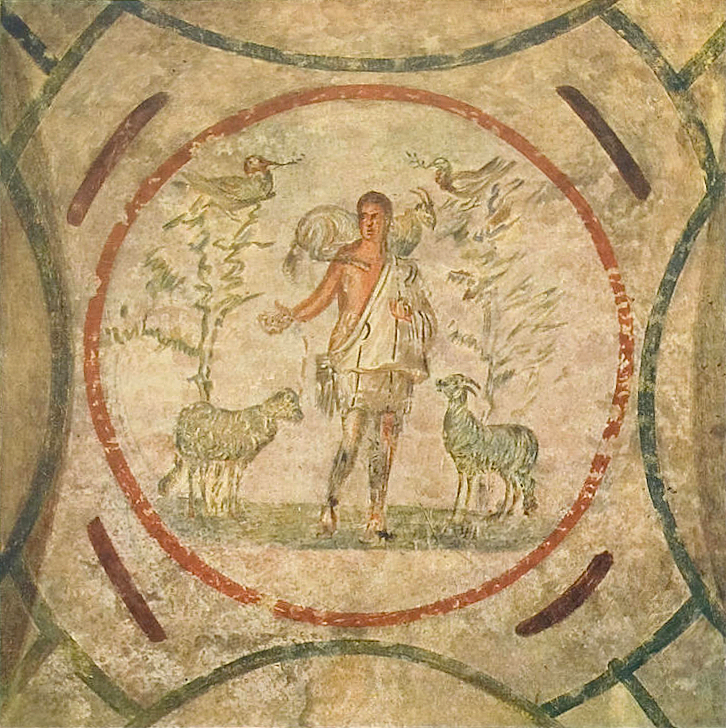
“The Good Shepherd”, Third Century, Catacombs of Priscilla, Rome.
This fresco was painted on the ceiling of a burial chamber in the Catacombs of Priscilla in Rome. The male figure in the centre looks like the Good Shepherd from chapter 10 of John’s Gospel and from the parable of the lost sheep, which is found in the Gospel of Luke (Lk 15:4-5). The image of the Good Shepherd has a strong resonance with the hope of an afterlife. Just think of how often the 23rd Psalm is chosen for funerals in our time. As is well known, the first Christian artists did not show the crucified Christ. They preferred the image of a shepherd. In the classical world, the shepherd with his sheep symbolised the peace and tranquility hoped for in the afterlife. The man in this image is shown with birds and animals in a pastoral scene and with pan pipes at his waist and might be understood as either the god Hermes or as Orpheus, who was also associated with the afterlife. These early Christian artists worked with an existing visual symbol, and gave it a specifically Christian meaning. This shepherd is a symbol of the truth that Christ is the Good Shepherd (Jn 10:14). However, this image points also to another passage, which has a bearing on our Easter faith. This becomes evident when you notice that while to the shepherd’s right there is a sheep, to his left there is a goat. Surely this alludes to the final judgement scene from Matthew: “Before him will be gathered all the nations, and he will separate them as a shepherd separates the sheep from the goats, and he will place the sheep at his right hand, but the goats at the left” (Mt 25:32-33). At the same time, this shepherd also carries an animal on his shoulders as in the parable from Luke 15. But in that parable, he carried one of the sheep. Here the animal he carries is definitely a goat! Luke’s parable concludes, “Just so I tell you there will be more joy in heaven over one sinner who repents than over ninety-nine righteous persons who have need no repentance” (Lk 15:7). And so this image suggests that the artist has put these two parables together, perhaps, to suggest that in the embrace of the Good Shepherd even goats may find redemption!
The Catholic Chaplaincy serves the students and staff of the University of Edinburgh, Edinburgh Napier University and Queen Margaret University.
The Catholic Chaplaincy is also a parish of the Archdiocese of St Andrews and Edinburgh (the Parish of St Albert the Great) and all Catholic students and staff are automatically members of this parish.